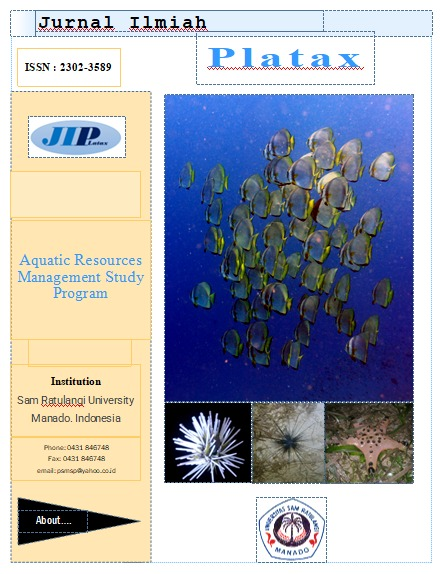Carbon Absorption in Seagrasses in Tongkaina Coastal Waters, Bunaken District, Manado City, North Sulawesi
Keywords:
Tongkaina Beach, seagrasses, biomass, carbon absorptionAbstract
This study was conducted to determine the types of seagrasses and calculate biomass and calculate how much carbon absorption in seagrasses was found in the location of Tongkaina Beach, Bunaken District, Manado City, North Sulawesi. The sampling procedure in the field is the method of cruising surveys. A cruising survey is a sample collection method that is carried out by walking through the coastal area of all seagrasses found. After the sampling at the site is completed, the sample in the inventory is then photographed. The samples that have been obtained are analyzed in the laboratory using the loss on ignition (LOI) method. The results of the study on Tongkaina coastal waters covering an area of 25,000 meters with a coastal length of ±500 meters, in an area parallel to the coastline as wide as ±50 meters towards the sea and six types of seagrasses were obtained, namely: Enhalus acoroides, Thalassia hemprichii, Syringodium isoetifolium, Cymodocea rotundata, Halodule uninervis, and Halodule pinifolia.  The biomass in seagrasses found had an average value of 78.10% with the highest individual seagrass biomass found in seagrass type Enhalus acoroides with a biomass value of 87.23grams of dry weight (gbk)/individual and the lowest type of seagrass individual biomass value was found in seagrass type seagrass with a biomass value of 66.67grams of dry weight (gbk)/individual. The total carbon content calculated in the entire seagrass obtained was 46,0941gC
Keywords: Tongkaina Beach; seagrasses; biomass; carbon absorption
Abstrak
Penelitian ini dilakukan untuk mengetahui jenis-jenis lamun dan menghitung biomassa serta menghitung berapa serapan karbon pada lamun yang ditemukan dilokasi Perairan Pantai Tongkaina Kecamatan Bunaken Kota Manado Provinsi Sulawesi Utara. Prosedur pengambilan sampel di lapangan menggunakan metode survei jelajah. Survei jelajah adalah metode pengumpulan sampel yang di lakukan dengan cara menyusuri daerah pantai terhadap semua lamun yang ditemukan. Setelah pengambilan sampel di lokasi selesai, sampel di inventarisir kemudian difoto. Sampel yang telah diperoleh dianalisa di laboratorium dengan menggunakann metode loss on ignition (LOI). Hasil penelitian pada perairan pantai Tongkaina seluas 25.000 meter dengan panjang pantai ±500 meter sejajar garis pantai dan lebar ±50 meter ke arah laut.  Ditemukan enam jenis lamun yaitu: Enhalus acoroides, Thalassia hemprichii, Syringodium isoetifolium, Cymodocea rotundata, Halodule uninervis dan Halodule pinifolia. Biomassa pada lamun yang ditemukan memiliki nilai rata-rata 78,53% dengan biomassa individu lamun tertinggi terdapat pada lamun jenis Enhalus acoroides dengan nilai biomassa mencapai 87,23gram berat kering (gbk)/individu dan nilai biomassa individu jenis lamun terendah terdapat pada lamun jenis Syringodium isoetifolium dengan nilai biomassa 66,67gram berat kering (gbk)/individu. Untuk total kandungan karbon yang dihitung pada keseluruhan lamun yang didapat sebesar 46,0941gC.
Kata kunci: Pantai Tongkaina; Lamun; biomasa, serapan carbon
References
Lestari, K. I. V., Hendrawan, I. G., & Faiqoh, E. Estimasi Simpanan Karbon pada Padang Lamun di Kawasan Pantai Karang Sewu, Gilimanuk, Bali.
Ganefiani, A., Suryanti, S., & Latifah, N. (2019). Potensi padang lamun sebagai penyerap karbon di perairan Pulau Karimunjawa, Taman Nasional Karimunjawa. Journal of Fisheries Science and Technology, 14(2), 115-122.
Gunawan, J. V., Parengkuan, M., & Zulpikar, F. (2019). Estimasi stok karbon pada biomassa lamun di Pulau Semak Daun, Kepulauan Seribu. OLDI (Oseanologi dan Limnologi di Indonesia), 4(2), 89-99.
Hartati, R., Pratikto, I., & Pratiwi, T. N. (2017). Biomassa dan estimasi simpanan karbon pada ekosistem padang lamun di Pulau Menjangan Kecil dan Pulau Sintok, Kepulauan Karimunjawa. Buletin Oseanografi Marina, 6(1), 74-81.
Irawan, A. (2017). Potensi cadangan dan serapan karbon oleh padang lamun di bagian utara dan timur Pulau Bintan. OLDI (Oseanologi dan Limnologi di Indonesia), 2(3), 35-48.
Kusumaningrum, M., Kusrahayu, K., & Mulyani, S. (2013). Pengaruh berbagai filler (bahan pengisi) terhadap kadar air, rendemen dan sifat organoleptik (warna) chicken nugget. Animal Agriculture Journal, 2(1), 370-376.
Larkum, A. W., Orth, R. J., & Duarte, C. M. (2006). Seagrasses: biology, ecologyand conservation. Phycologia, 45(5), 5.
Nabil, Z. (2018).Pengenalan Padang Lamun, Suatu Ekosistem yang Terlupakan. Unimal Press. Sulawesi.
Romadoni, N. V. (2021). Biomassa dan estimasi simpanan karbon ekosistem lamun di perairan pantai tunggul kecamatan paciran kabupaten lamongan (Doctoral dissertation, UIN Sunan Ampel Surabaya).
Rustam, Agustin. Susetyo, Novi, A., Daulat, August., Kiswara, Wawan,.
Suhernawan, Deny. Yusup., Rappe, Rohani Ambo. (2019). Pedoman pengukuran karbon di ekosistem padang lamun. Bandung
Siagian, Y., Zulkifli, Z., & Efriyeldi, E. (2017). C-organic Content in the Seagrass Leaf on Different Kinds seagrass of Island Poncan in Sibolga, North Sumatera Province (Doctoral dissertation, Riau University).
Downloads
Published
How to Cite
Issue
Section
License
Copyright (c) 2022 Dilivia J. Namoua, Adnan S Wantasen, Khristin I. F Kondoy, Rene Ch. Kepel, Febry S. I Menajang, Wilmy Pelle

This work is licensed under a Creative Commons Attribution-NonCommercial 4.0 International License.
COPYRIGHT
Authors who publish with this journal agree to the following terms:
Authors hold their copyright and grant this journal the privilege of first publication, with the work simultaneously licensed under a Creative Commons Attribution License that permits others to impart the work with an acknowledgment of the work's origin and initial publication by this journal.
Authors can enter into separate or additional contractual arrangements for the non-exclusive distribution of the journal's published version of the work (for example, post it to an institutional repository or publish it in a book), with an acknowledgment of its underlying publication in this journal.
Authors are permitted and encouraged to post their work online (for example, in institutional repositories or on their website) as it can lead to productive exchanges, as well as earlier and greater citation of the published work (See The Effect of Open Access).




















